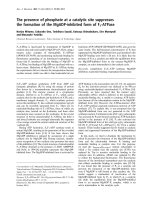The Sector’s “Positives” at a glance 1992-2012 doc
Bạn đang xem bản rút gọn của tài liệu. Xem và tải ngay bản đầy đủ của tài liệu tại đây (1.24 MB, 27 trang )
IMPROVEMENT IN DAIRY SECTOR AND
FUTURE STRATEGY
Monday 19
th
, 2012
The Sector’s “Positives” at a glance
1992-2012
1. Increase in milk production.
2. Improvement in milk collection infrastructure.
3. Development of corporate farms/commercial dairy
farms.
4. Improvement in animal husbandry practices.
5. Breed improvement initiatives in the “cross breeding"
category and training of small holders.
6. Involvement of more agencies in dairy development
such as Agri-services by dairy industry, PLDDB,
SMEDA ,UNDP, CIDA, FAO and many other NGOs
1. Milk Production Statistics
PRODUCTION OF MILK
(1000 tonnes)
1999-
2001
2003-
2005
2007
2008
2009
25,575
28,624
32,219
33,270
34,362
Source: Food and Agriculture Organization of the United Nations : Year book 2010
2. Milk Collection infrastructure
Direct Ice Addition
Chilling
Equipment
From:
To:
1992
VMC
Milk collection infrastructure Contd.’
Chilling set-up at a local farm at GOJRA
3. Development of corporate/commercial
dairy farms
Feeding Table at a local farm (Punjab)
Corporate/Commercial Farm
A local commercial farm (Punjab)
4. Improvement in animal husbandry
practices
1. The shed design has been adapted for local climate (all
three seasons). It includes improved “cow comfort”
concept, free access to feed and water and cubicles.
2. Improved animal cooling systems (Water sprinkling and
cooling).
3. Improved fodder production for animal nutrition.
4. Launch of corn silage production at large scale.
5. Improvement in milk yield (20-22 liters per animal per
day. Cow lactation yield 7,000 liters / year).
6. Gradual participation of small holders in managing the
animal health and disease control.
Cow Comfort:
Sand Cubicles at a local farm
Improved Shed designs
- Concrete shed at a local farm in Punjab
4.1 Dairy Farming and husbandry Best
Practices in Pictures
4.2 Silage Production
Silage production at a large Farm
4.2 Silage Production
* Silage Production at a local farm in Punjab
Issues with the dairy sector
1. Are the national data of buffalo and cow populations reliable
and is the total milk quantity really 34 billion liters per annum??
2. Complete lack of herd recording, herd book keeping, lactation
records, pedigrees and progeny testing of stud bulls, contrary to
international best practices.
3. Annual demand for milk is increasing by 10-20%, whereas the
milk production is growing approximately 4% per annum only.
4. Pakistan is 4
th
largest milk production country in the World,
however, the fact is that 40,000 tons of dry milk is being
imported into Pakistan annually, equivalent to 320,000 tons of
fresh liquid milk.
Dairy sector - Issues
Fodder shortage : Fodder management has not improved. Fodder shortages are still
there during seasonal changes (Rabbi and Kharif)
0
500
1000
1500
2000
2500
Daily Milk volume (kg)
Days
2006 2007 2008 2009
Jan Feb Mar Apr May Jun Jul Aug Sep Oct Nov Dec
Source: NPL milk collection
Dairy sector - Issues
4. Yield from local livestock is very low. Animals from small
holders have a daily average yield of 3-8 liters.
5. Dairy business awareness, training and market linkages in
best farm practices throughout the regions is required to
improve the small holders dairy output in general.
Future Strategy
There is an urgent need for launching a comprehensive policy
for breed improvement of both buffalo and cattle for dairy and
beef.
Controlled legislation for local cattle semen and buffalo semen
production.(SPUs)
Improvement in method of data collection to formulate
authentic statistics of the livestock sector.
Reinforce quality production of local vaccines and ensure
proper vaccination of livestock in rural areas.
Quality controls to be enforced on raw/loose milk.
About
Dairy and Rural Development
Foundation
Established in 1996 by interested cattle breeders ,
extension workers, milk industry.
A charitable, non-profitable, non-political and
non-government organization (NGO).
Registered under the Societies Registration Act,
XXI, 1860 of Joint Stock Companies, Lahore,
Punjab.
Provides a platform to create link between
farmers, self employed breed technicians and
dairy development agencies working for the dairy
sector betterment in the country
Brief Introduction of DRDF
Artificial Insemination Technician Training in
collaboration with Punjab Vocational Training Council
(PVTC)
Training course duration 30 days
Practical training covered at Large Animal Slaughter
House, Lahore.
Training to other Agencies / Dairy Industry
Nestle Pakistan Ltd.
Livestock & Dairy Development Board (LDDB)
Plan Pakistan (NGO)
PRSP (NGO)
NRSP (NGO)
Red Cross (NGO)
200 AIT
training
yearly
Artificial Insemination Technician Training
3 liter/day
16 litre/day
Breed Improvement through AI
DRDF trained AI Technician
Issues
relating to
animal
health !
Dairy Project – DRDF-USAID
United States Agency for International Development
(USAID)
Nestle’ Pakistan Ltd.
UVAS: University of Vet. and Animal Sciences Lahore
(MOU): Curriculum ,Testing and Certification for LLWs.
DRDF: Contingency and support services to the buildup
during project.
AI: Semen and Liquid Nitrogen Supply.
Vet medicines ,Conc. Feeds, Minerals, supplies to LLW.
Farm Equipment ,supply silage machines
Linkages to markets (stakeholders).
Micro finance
Partners in implementation
Overview
1. Target Areas: Punjab Province, Southern Punjab i.e. Sahiwal,
Bahawalpur, Multan, Okara, Rahimyar Khan etc.
2. Proposed Time Frame: 3 years, (June 2011 to June 2014)
3. 9,000 Famers to be trained in best dairy farm practices out of which
100 Farm Managers to be trained for mechanized and modern large
dairy farms.
4. 2,000 A.I Technicians self employed ,breed improvement.
5. 5,000 Lady Livestock workers(LLW) to be trained as animal nurse and
Small Business Entrepreneur (SBE).
6. Mass Awareness Program for Farmers in best Farm Practices through
Electronic, Print media and Mass awareness tools.
• A.I training in :Burj Attari (Lahore) and South
Punjab (Multan).
• Farmers and LLW’s :Training in NPL Sukheki,
NPL Sarsabz, Kamalia, PirMahal and
Chichawatni.
• Project is expanding its operations over other
areas of South Punjab and will cover some
portion of Baluchistan and Sindh towards the
end of the Project.
Overview
Baluchistan
NWFP
Punjab
Sindh
Lahore
DRDF-USAID Project Office
Chechavatni
Zone
Sarsabz
Training Farm
for farmer
Sukheki
Training Farm
for Farmer
Burj Attari
AI Technicians
Training Farm
Multan
AI
Technician
Training
Farm
Peer
Mahal
Zone
Project Coverage Map
Khanewal
(Farmer
trainings)
Kamalia
(Farmer
training)









